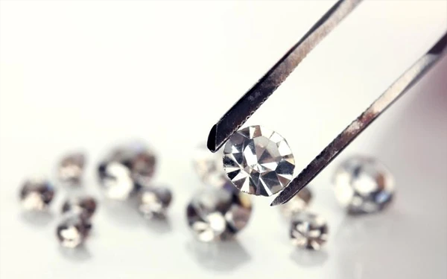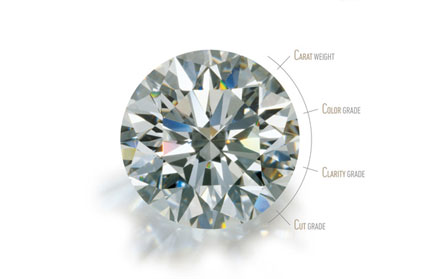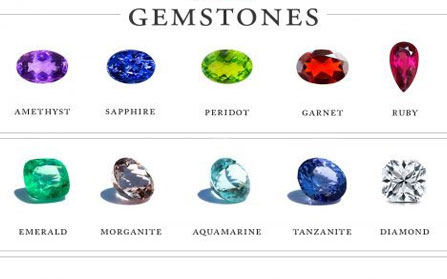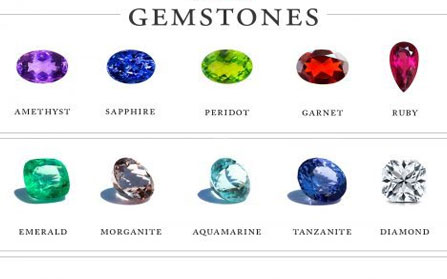Gemstone Guide
Gemstone Guide
There are over two hundred recognized gemstones. Most are minerals and are cut from naturally occurring crystals. To qualify as a gem, the specimen should be hard and tough to resist scratching and have beautiful clarity, color or 'fire'.
Diamonds form about 100 miles (161 km) below the Earth's surface, in the molten rock of the Earth's mantle, which provides the appropriate amounts of pressure and heat to transform carbon into diamond. Powerful magma eruptions or volcanic activities brought the diamonds to the surface, creating kimberlite pipes. Most diamonds that we see today were formed millions (if not billions) of years ago.
Diamonds may also be found in river beds, which are called alluvial diamond sites. These are diamonds that originate in kimberlite pipes, but get moved by geological activity. These primary sources form the basis for the world's diamond mines.
Gemstones are used to add color to jewellery and make it look more vibrant and lively. Here’s how gemstones derive its color, The color of any material is due to the nature of light itself. Daylight, often called white light, is actually all of the colors of the spectrum combined. When light strikes a material, most of the light is absorbed while a smaller amount of a particular frequency or wavelength is reflected. The part that is reflected reaches the eye as the perceived color. A ruby appears red because it absorbs all the other colors of white light (green and blue), while reflecting the red. Even the same gemstone can occur in many different colors: sapphires show different shades of blue and pink and "fancy sapphires" exhibit a whole range of other colors from yellow to orange-pink.
For most people buying Gemstones is a complicated task. There are many fake colored stones which are sold in the name of gemstones. So it is advisable that you buy precious gemstones from a trusted source.
Many factors set value. Things like weight, intensity of color, size, rarity, quality and also the country of origin are deciding factors for the price it commands. Gemstones may be accompanied by a lab report listing the color, cut, clarity and weight. They may also contain a comment about treatments or origin. Certain gemstones such as ruby or sapphire can receive a premium in the market if they are believed to be from a particular country (origin). Nature produces far fewer of the top quality gems, so there is good reason for the greater price.
 January
January
Garnet February
February
Amethyst March
March
Aquamarine April
April
Diamond May
May
Emerald June
June
Alexandrite July
July
Ruby August
August
Peridot Septemner
Septemner
Sapphire October
October
Opal November
November
Topaz December
December
Zircon
Ruby is included in the top three gemstones alongwith emeralds and sapphires. Rubies have always been held in high esteem by jewellery buyers.
Color: Rubies vary in color from orangey red, red slightly purplish red, strongly purplish red, to red. The brightest and most valuable "red" called blood-red, commands a large premium over other rubies of similar quality. A minimum color saturation must be met to be called a ruby, otherwise the stone will be called a pink sapphire. Clarity: Type II May be eye clean with minor inclusions visible under magnification.
Cut: Some native cuts may be found (gems cut at the mine location without high regard to skill in cutting). However, well-cut stones are available.
Emeralds are perhaps the most popular and preferred choice of gemstone because of their versatile green color and is one of the three most prized gemstones in the industry with rubies and sapphires. Most emeralds are highly included, so their toughness (resistance to breakage) is classified as generally poor.
Color: Emeralds occur in hues ranging from yellow-green to blue-green, with the primary hue necessarily being green. Only gems that are medium to dark in tone are considered emerald; light-toned gems are known as green beryl. The finest emeralds are approximately 75% tone on a scale where 0% tone would be colorless and 100% would be opaque black. Clarity: Stones that lack surface breaking fissures are extremely rare and therefore almost all emeralds are treated ("oiled") to enhance the apparent clarity. Cut: Emeralds more likely than other gemstones to be cut into cabochons, rather than faceted shapes due to its crystal non uniformity
Carat weight: Stones weighing more than 8 carats are rare in finer quality. In commercial qualities, stones are available in all sizes up to 20 carats or even larger may be encountered.
Sapphire is considered one of the “big three” in the industry with ruby and emeralds. The word “sapphire” derives from Sanskrit word ‘Shanipriya’ literally meaning “dear to Saturn”.
Color: Sapphires can be found in a variety of colors in each of the seven primary hues. However, blue is the most common, most desired, and most expensive. The color of fine blue sapphires may be described as a vivid medium dark violet to purplish blue where the primary blue hue is at least 85% and the secondary hue no more than 15%, without the least mixture of a green secondary hue or a gray mask. Clarity : Look for stones that are eye-clean meaning no inclusions that are visible to the naked eye. Extremely fine silk throughout the stone can enhance the value of some sapphires. However too much silk weakens the color, making it appear undesirably grayish.
Cut: Various shapes and cuts such as ovals, cushions, and rounds are seen as are other shapes such as the heart or emerald cut.
The ideal pearl is perfectly round and smooth, but many other shapes of pearls (baroque pearls) occur. The finest quality natural pearls add a great deal of beauty to jewellery and are admired by the masses and classes alike. The natural pearls are the most valuable and expensive. Cultured or farmed pearls from pearl oysters form the majority amount of pearls sold. Imitation pearls are also widely sold in artificial jewelry, but its quality is usually very poor.
- January: Garnet
- February: Amethyst
- March: Aquamarine
- April: Diamond
- May: Emerald
- June: Alexandrite
- July: Ruby
- August: Peridot
- September: Sapphire
- October: Opal
- November: Topaz
- December: Zircon (now tanzanite on some lists)








The information below is required for social login